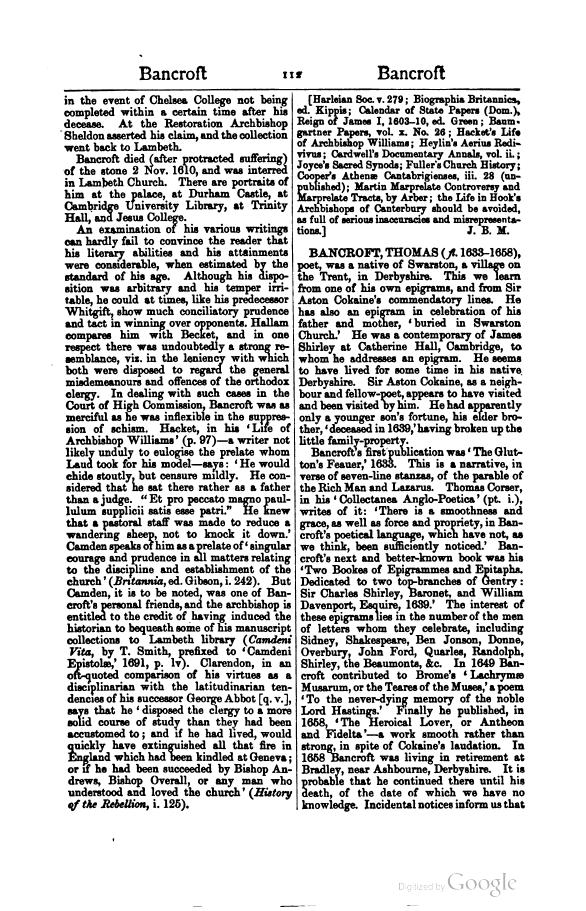in the event of Chelsea College not being completed within a certain time after his decease. At the Restoration Archbishop Sheldon asserted his claim, and the collection went back to Lambeth.
Bancroft died (after protracted suffering) of the stone 2 Nov. 1610, and was interred in Lambeth Church. There are portraits of him at the palace, at Durham Castle, at Cambridge University Library, at Trinity Hall, and Jesus College.
An examination of his various writings can hardly fail to convince the reader that his literary abilities and his attainments were considerable, when estimated by the standard of his age. Although his disposition was arbitrary and his temper irritable, he could at times, like his predecessor Whitgift, show much conciliatory prudence and tact in winning over opponents. Hallam compares him with Becket, and in one respect there was undoubtedly a strong resemblance, viz. in the leniency with which both were disposed to regard the general misdemeanours and offences of the orthodox clergy. In dealing with such cases in the Court of High Commission, Bancroft was as merciful as he was inflexible in the suppression of schism. Hacket, in his ‘Life of Archbishop Williams’ (p. 97)—a writer not likely unduly to eulogise the prelate whom Laud took for his model—says: ‘He would chide stoutly, but censure mildly. He considered that he sat there rather as a father than a judge. “Et pro peccato magno paullulum supplicii satis esse patri.” He knew that a pastoral staff was made to reduce a wandering sheep, not to knock it down.’ Camden speaks of him as a prelate of ‘singular courage and prudence in all matters relating to the discipline and establishment of the church’ (Britannia, ed. Gibson, i. 242). But Camden, it is to be noted, was one of Bancroft's personal friends, and the archbishop is entitled to the credit of having induced the historian to bequeath some of his manuscript collections to Lambeth library (Camdeni Vita, by T. Smith, prefixed to ‘Camdeni Epistolæ,’ 1691, p. lv). Clarendon, in an oft-quoted comparison of his virtues as a disciplinarian with the latitudinarian tendencies of his successor George Abbot [q. v.], says that he ‘disposed the clergy to a more solid course of study than they had been accustomed to; and if he had lived, would quickly have extinguished all that fire in England which had been kindled at Geneva; or if he had been succeeded by Bishop Andrews, Bishop Overall, or any man who understood and loved the church’ (History of the Rebellion, i. 125).
[Harleian Soc. v. 279; Biographia Britannica, ed. Kippis; Calendar of State Papers (Dom.), Reign of James I, 1603–10, ed. Green; Baumgartner Papers, vol. x. No. 26; Hacket's Life of Archbishop Williams; Heylin's Aerius Redivivus; Cardwell's Documentary Annals, vol. ii.; Joyce's Sacred Synods; Fuller's Church History; Cooper's Athenæ Cantabrigienses, iii. 28 (unpublished); Martin Marprelate Controversy and Marprelate Tracts, by Arber; the Life in Hook's Archbishops of Canterbury should be avoided, as full of serious inaccuracies and misrepresentations.]
BANCROFT, THOMAS (fl. 1633–1658), poet, was a native of Swarston, a village on the Trent, in Derbyshire. This we learn from one of his own epigrams, and from Sir Aston Cokaine's commendatory lines. He has also an epigram in celebration of his father and mother, ‘buried in Swarston Church.’ He was a contemporary of James Shirley at Catherine Hall, Cambridge, to whom he addresses an epigram. He seems to have lived for some time in his native Derbyshire. Sir Aston Cokaine, as a neighbour and fellow-poet, appears to have visited and been visited by him. He had apparently only a younger son's fortune, his elder brother, ‘deceased in 1639,’ having broken up the little family-property.
Bancroft's first publication was ‘The Glutton's Feauer,’ 1633. This is a narrative, in verse of seven-line stanzas, of the parable of the Rich Man and Lazarus. Thomas Corser, in his ‘Collectanea Anglo-Poetica’ (pt. i.), writes of it: ‘There is a smoothness and grace, as well as force and propriety, in Bancroft's poetical language, which have not, as we think, been sufficiently noticed.’ Bancroft's next and better-known book was his ‘Two Bookes of Epigrammes and Epitaphs. Dedicated to two top-branches of Gentry: Sir Charles Shirley, Baronet, and William Davenport, Esquire, 1639.’ The interest of these epigrams lies in the number of the men of letters whom they celebrate, including Sidney, Shakespeare, Ben Jonson, Donne, Overbury, John Ford, Quarles, Randolph, Shirley, the Beaumonts, &c. In 1649 Bancroft contributed to Brome's ‘Lachrymæ Musarum, or the Teares of the Muses,’ a poem ‘To the never-dying memory of the noble Lord Hastings.’ Finally he published, in 1658, ‘The Heroical Lover, or Antheon and Fidelta’—a work smooth rather than strong, in spite of Cokaine's laudation. In 1658 Bancroft was living in retirement at Bradley, near Ashbourne, Derbyshire. It is probable that he continued there until his death, of the date of which we have no knowledge. Incidental notices inform us that
